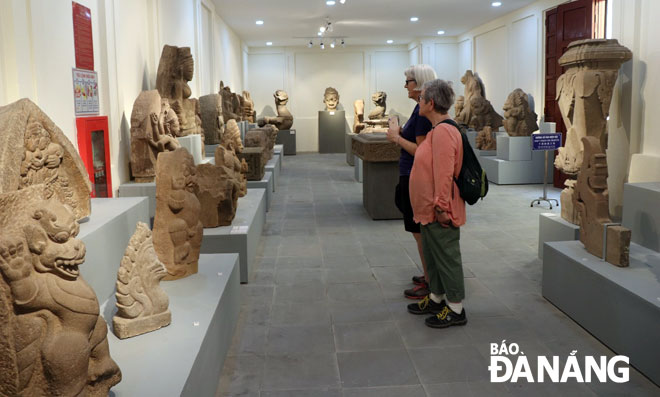New display spaces opened at Museum of Cham Sculpture
To celebrate its 100th anniversary, the Da Nang-based Museum of Cham Sculpture has opened a new display of 47 artifacts at its open storage, and a special gallery on findings from excavations conducted at the Cham relic site in Phong Le Village, Hoa Tho Dong Ward, Cam Le District from 2011 to 2018.
 |
| The display of 47 artifacts at the open storage attracting a great deal of attention from visitors at the Museum of Cham Sculpture |
The 47 sandstone artifacts on display at the open storage feature such different types as pedestals, round-shaped statues, bass-reliefs and architectural decoration patterns. On the spotlight at the display are valuable sculptures of Garuda legendary bird, Makara water monster, and Kala-the god of the underworld in traditional Javanese, and Balinese mythology.
According to domestic researchers, the Phong Le Village-based Cham relic site is one of the important Cham tower sites boasting great historical and cultural values across Da Nang. This venue is thought to date back to the 10th century, and it was preserved by the Cham people until at least the 12th century.
From 2011 to 2018, the Museum of Cham Sculpture joined forces with the Faculty of History of the Ha Noi University of Social Sciences and Humanities to conduct 3 excavations at the Phong Le Village-based Cham relic site.
On display at this newly-opened special gallery are a total of 76 artifacts made from such materials as stone, quartz and ceramics. Included are the statues of Sinha, or lion, Garuda legendary bird's head, Naga snake-like statues, an elephant-shaped altar, pieces of unique decorative patterns, and fragments of bricks.
These artifacts help researchers and archaeologists partly understand about the architectural characteristics, sculpture arts and religious culture of the Cham people, as well as cultural values, and architectural history of the Village’s Cham relic site.
The first structure in what is now the Da Nang Museum of Cham Sculpture was built in 1915. The establishment of a museum of Cham sculpture in Da Nang was first proposed in 1902 by Henri Parmentier, a prominent expert of the Ha Noi-based L’École Française d’Extrême-Orient (EFEO). The first building was designed by two French architects, M. Deleval and M. Auclair, who were inspired by Henri Parmentier to use traditional Cham elements in the design. Over the years, the museum has been extended twice, but the unique combination of Cham and French colonial architecture has been preserved.
The museum is thought to have been one of the first 3 museums to be established in Viet Nam. With support from the EFEO, the city’s museum has become one of the world's most famous collections of Cham artifacts.
According to Mr Ho Tan Tuan, the museum’s Director, the museum now features an image displaying room, an archaeology-themed room, 2 galleries on Cham ethnography in south central region and Sa Huynh cultural achievements, and 10 Cham sculpture arts galleries including My Son, Tra Kieu, Dong Duong and Thap Mam.
In particular, the museum’s exhibits are arranged in a geographic order according to the places where they were found. This arrangement helps visitors understand the various styles of Cham architecture, which differs according to local lifestyles and culture.
Mr Tuan revealed the museum’s staff are collecting precious artifacts on the establishment and development of the museum, especially images of French people organising exhibitions here, and the leaders of other countries during their museum visits during the 1930s.
Besides, heed will be paid to promoting the application of a multi-lingual audio guide app in a bid to diversify, and enhance the quality of guide services at the museum. Accordingly, visitors can access audio recordings in many foreign languages to gain an insight into the history, origin, place names, and information about available artifacts on display here.